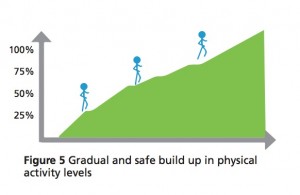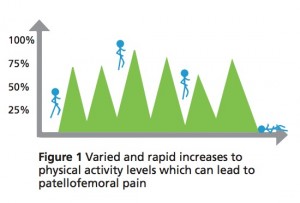
While individual cases of runner’s knee need to be treated at face value, with no one-size-fits-all cure, there are a few key areas that I consider when managing running patients with pain at the front of their knee. These factors are important in understanding how to cure runner’s knee:
- Load Management
- Rehabilitation (Exercise)
- Running Retraining
- Therapeutic Adjuncts
How to Cure Runner’s Knee – Load Management
I am going to write a four-part series on the topic of how to cure runner’s knee, firstly focusing on load management…
But what does ‘load management’ actually mean?
In short, it relates to controlling the amount of load (exercise) you subject your body to, both in terms of total running volume and increases/decreases. To keep it simple, think about it as avoiding doing too much, too soon.
This is a clear message from the excellent patent information leaflet produced by my good friends & colleagues Dr. Christian Barton (Melbourne, Australia) and Dr. Michael Rathleff (Aalborg, Denmark), best summarised by these two images.


It must be stressed that load is a good thing for the human body. We are remarkably adaptable creatures, and the correct amount of load will lead to positive adaptation within the tissues.
Load too little, you will not adapt. Load excessively, you may break down. I personally like the term “zone of optimal stress” to describe the middle ground which will provide a training effect without breakdown and injury.
So how can we make this a measurable target for the average runner?
Although it will be individual to every athlete and may vary in each training cycle, there are some guidelines that apply to most runners.
The first target to present is 20%.
This comes from an excellent paper from Scandinavia, looking at the risk of running injury with varied training progressions. Those who increase their training volume by 30% each week are more at risk of injury than those who progress by 10%. This tells me that the “average” safe zone for a typical runner lies on or around the 20% progression mark.
View this as an individual run variable as well as a weekly volume variable.
For example, if your longest run in a week was 10 miles, it should not exceed 12 miles the following week. If your weekly volume was 30 miles, it should not exceed 36 miles the following week. Use this for decreasing volume as well.
The human body likes consistency as well as variability and always remember that your tissues adapt to the loads that you place on them. So while gradual progression is important, so is a gradual approach to reducing training loads.
Remember that this is generic advice, and will need to be tweaked for every runner and every training cycle.
If you make a progression and your body complains, do not be afraid to strip things back a little. Conversely, if you feel as though you are capable of more, push your boundaries with a degree of caution.
If you are recovering from an injury, you should experience a maximum of 4/10 pain during a run, which should have cleared by the next morning. If this is not the case, you may be pushing yourself too hard.
FREE DOWNLOAD: Runner’s Knee Rehab Resources [PDF]
The other guidance we can offer comes from the excellent new paper from the British Journal of Sports Medicine, by Sports Scientist Tim Gabbett.
This paper describes something called a “chronic workload ratio”, with sudden spikes in acute workload shown to cause more injury than chronic workloads.
Here’s what that means:
If you are a marathon runner, your chronic workload would be your typical base endurance volume (long, steady runs). This volume alone does not necessarily increase your risk of injury. However, let’s say you choose to enter a 5KM and start to do lots of speed work. This would be a spike in your acute workload, which was found to increase your risk of injury.
The key message here is to consider your training zones (steady state, threshold, tempo, tolerance) as variables to apply the 20% training rule to, not just the sheer amount of training that you do.
Summary
Training progressions are a good thing. The human body is a robust organism, often capable of more than we think. However, push it too far and it may bite back, often in the form of injury or a slower recovery from a current injury.
Progress gradually, listen to your body and if in doubt, seek the advice on how to cure runner’s knee from a professional such as a running specialist physiotherapist!
The post Can You Cure Runner’s Knee [Part 1] appeared first on Run Coaching, Ironman and Triathlon Specialists - Kinetic Revolution.
from Run Coaching, Ironman and Triathlon Specialists – Kinetic Revolution http://www.kinetic-revolution.com/can-you-cure-runners-knee-part-1/



No comments:
Post a Comment